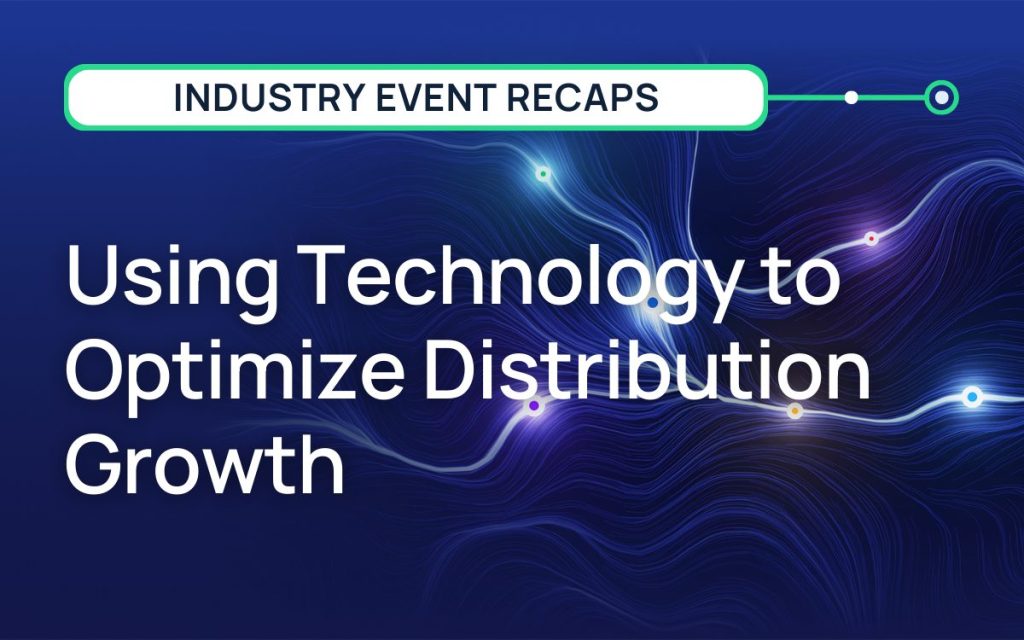Using Technology to Optimize Distribution Growth

A recap of AgentSync’s VP of Sales, Ryan Ward’s workshop at this year’s Insurtech Insights Conference in New York
In an age when it’s difficult to attract and retain talent in the industry, how can insurance organizations prioritize growth?
That was the question on everyone’s mind as they participated in a workshop headed by Ryan Ward, Vice President of Sales at AgentSync, Tom Davis, Vice President of Insurance at OpenSymmetry, and Zach Burnett, EVP of Global Field Operations at Varicent at the 2023 Insurtech Insights America Conference.
The workshop covered everything from details of the partnership between the three companies to questions about how to best handle the insurance industry talent crisis. If you weren’t able to catch the session in real-time, we invite you to watch the recording, or, if you’d prefer, keep reading as we recap the highlights of the conversation.
What industry problems are AgentSync, OpenSymmetry, and Varicent trying to solve through their partnership?
The discussion started with an exploration of the partnership between the three companies running the workshop: AgentSync, OpenSymmetry, and Varicent.
A major issue the insurance industry (or really any industry) faces is the disconnect between the numerous systems that companies leverage to collect their data. Ward noted that this partnership was about figuring out how to best leverage all that data by putting it into a format that allows people to make better business decisions in real-time.
Ward calls Tom Davis and the team at OpenSymmetry the “glue” that sticks it all together, noting how they came in and designed a program and workflows that allowed system A to talk to system B. The folks at Varicent and AgentSync represent the vendor side of the partnership, and help support OpenSymmetry by providing a more modern tech stack than the insurance industry is typically known for.
The results of the partnership have been widely positive. The ability to bring in NIPR data, compensation data, and more gives insurance professionals a view of the entire agent experience under one combined solution. This solves the problem of disjointed systems and helps insurance organizations grow their distribution channels without sacrificing compliance.
Does AgentSync run on its own platform or integrate directly with an agency’s AMS or client portal?
As technology was the main focus of the workshop, it made sense that the next question had to do with the technology behind the AgentSync platform. As Ward pointed out in the discussion, AgentSync is built on the Salesforce platform, but that doesn’t mean you have to be a Salesforce customer to use our solution. While that’s a common misconception about AgentSync, the truth is, only about 50 percent of our current customer base is on the Salesforce platform.
We like to think of it as giving our customers the ability to choose their own adventure. AgentSync can exist either as a standalone product or it can integrate with client relationship management (CRM) tools as well as other tools and client portals that aren’t Salesforce-specific.
What’s one of the greatest unsolved challenges the insurance industry is currently facing?
When someone asked a question about current challenges, Ward brought up the talent crisis the insurance industry is facing. “One of the challenges we’re hearing is that the agent population is aging in a big way,” he said. And it’s true. Producers are aging out of the workforce in massive waves, and younger generations are showing a significant lack of enthusiasm when it comes to filling the spots left behind.
One thing we know for sure: The role of the insurance agent isn’t going anywhere soon. While the “death of the insurance agent” might have felt like a very real possibility five or ten years ago, producers have proven their worth time and time again against the threats of AI and other digital tools and disruptors.
So how can insurers attract younger generations, or individuals looking for a career change, to a job in insurance? Discussion attendees had various answers ranging from boots on the ground at university job fairs to digital modeling aimed at evaluating high industry performers and targeting applicants with similar characteristics.
Ward made sure to mention that often it’s what happens after an individual is hired that turns them off from working in the insurance industry. If antiquated processes characterize a new recruit’s first experience in the field, they’ll likely walk away with a not-so-positive take on the industry.
By focusing on modern insurance infrastructure and providing an exceptional producer experience from onboarding to offboarding, insurance leaders can have a greater shot at attracting (and retaining) new talent.
It’s all in the name of distribution growth
At the end of the day, the partnership between the three companies is aimed at helping insurance organizations grow. By streamlining producer processes from onboarding to appointing to offboarding, organizations can better attract new talent and set up their current distribution partners for success.
When it’s easier to do business with your organization, employees and partners alike are more likely to continue doing so. AgentSync provides insurance compliance technology that can help your organization scale at a rate you never imagined, without sacrificing accuracy and compliance. If you’re interested in learning more contact us or schedule a demo today.

